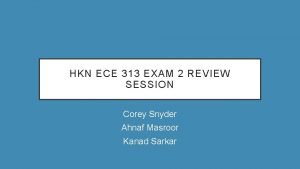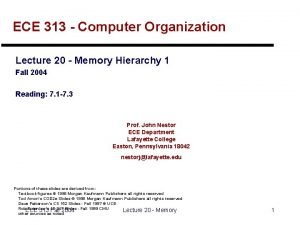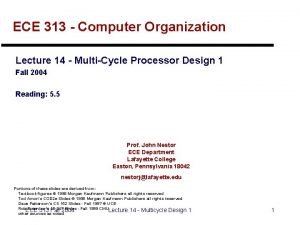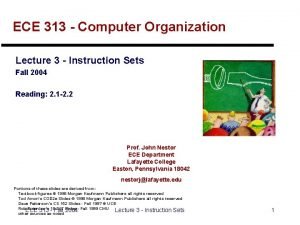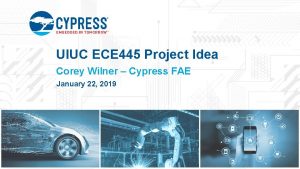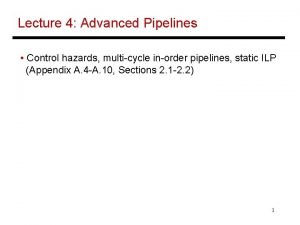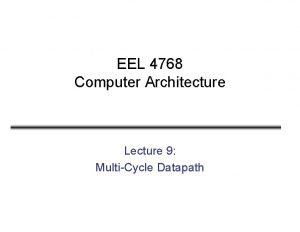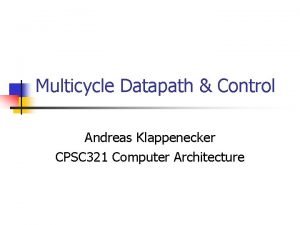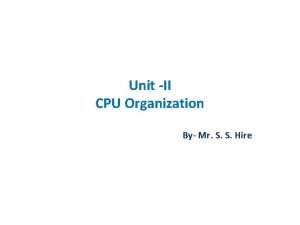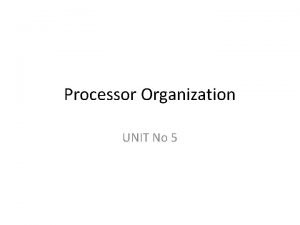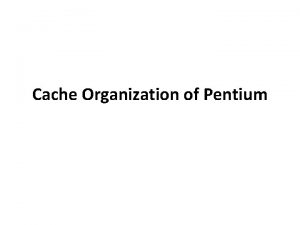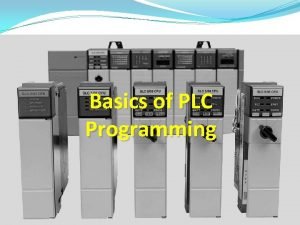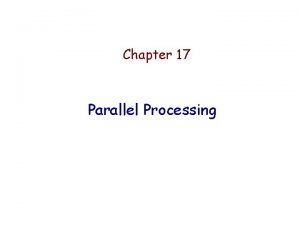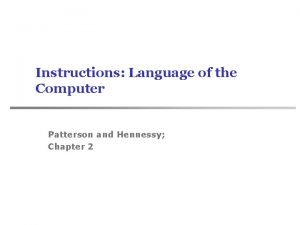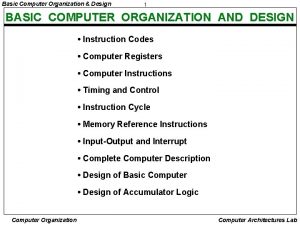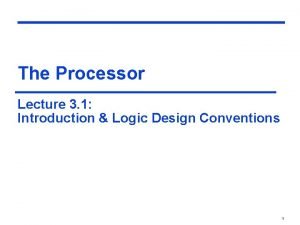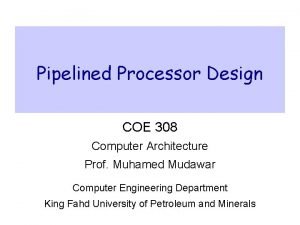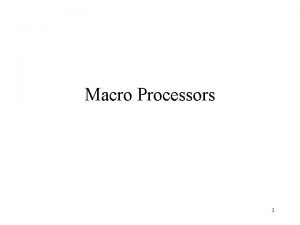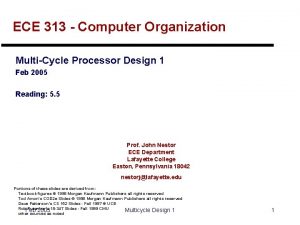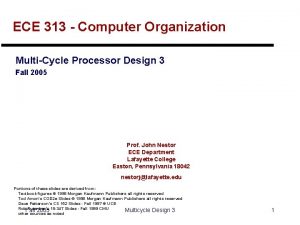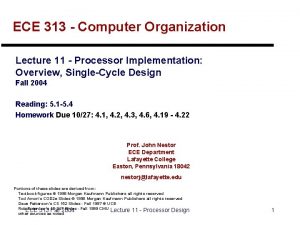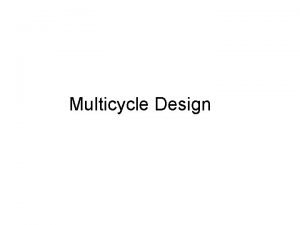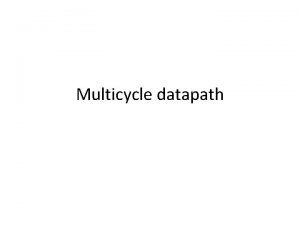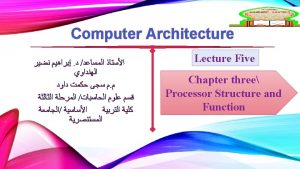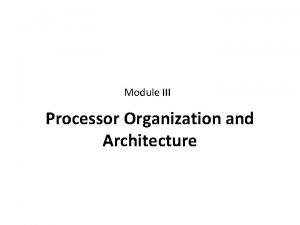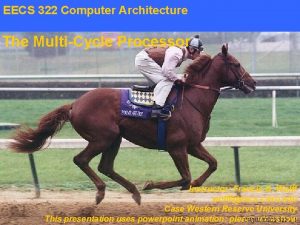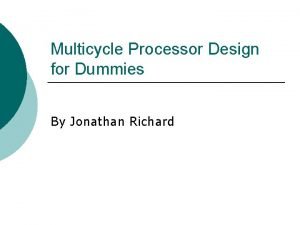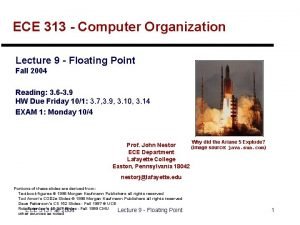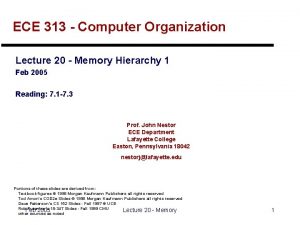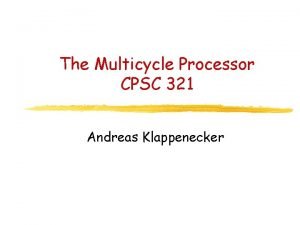ECE 313 Computer Organization MultiCycle Processor Design 2












![Example Problem: Datapath 3 2 1 0 Reg[rs] What needs to be changed? Fall Example Problem: Datapath 3 2 1 0 Reg[rs] What needs to be changed? Fall](https://slidetodoc.com/presentation_image_h2/a74c4187181febd77ff46851fb5dec28/image-13.jpg)















- Slides: 28

ECE 313 - Computer Organization Multi-Cycle Processor Design 2 Fall 2005 Reading: 5. 6 - 5. 11, C. 4 - C. 5 HW Due Fri. 5/11: 5. 32, 5. 34, 5. 35, 5. 47, 5. 49, 5. 55 Prof. John Nestor ECE Department Lafayette College Easton, Pennsylvania 18042 nestorj@lafayette. edu Portions of these slides are derived from: Textbook figures © 1998 Morgan Kaufmann Publishers all rights reserved Tod Amon's COD 2 e Slides © 1998 Morgan Kaufmann Publishers all rights reserved Dave Patterson’s CS 152 Slides - Fall 1997 © UCB Rob Rutenbar’s 18 -347 Slides - Fall 1999 CMU Fall 2005 Multicycle Design 2 other sources as noted 1

Outline - Multicycle Design } } } } Overview Datapath Design Controller Design Aside: FSM Design in Verilog Performance Considerations Extending the Design: An Example Microprogramming Exceptions Fall 2005 Multicycle Design 2 2

Review State Machine Design } Traditional Approach: } } Create State Diagram Create State Transition Table Assign State Codes Write Excitation Equations & Minimize } HDL-Based State Machine Design } Create State Diagram (optional) } Write HDL description of state machine } Synthesize Fall 2005 Multicycle Design 2 3

Review - State Transition Table / Diagram } Transition List - lists edges in STD PS IDLE BEEP WAIT Condition ARM' + DOOR' ARM*DOOR ARM ARM' NS IDLE BEEP WAIT IDLE BEEP IDLE Output 0 0 1 1 0 0 ARM • DOOR BEEP Honk=1 IDLE ARM’ + ARM • DOOR’ = ARM’ + DOOR’ ARM ARM’ WAIT Fall 2005 Multicycle Design 2 4

Example: MIPS Control Unit Fall 2005 Multicycle Design 2 5

Review: Full Multicycle Implementation Fall 2005 Multicycle Design 2 6

Controller Implementation } Typical Implementation: Figure 5 -37, p. 338 } Variations } Random logic } PLA } ROM Combinational Control Logic • address lines = inputs • data lines = outputs • contents = “truth table” State Datapath control outputs Next State Inputs from Instr. Reg (opcode) Fall 2005 Multicycle Design 2 7

Outline - Multicycle Design } } } } Overview Datapath Design Controller Design Aside: FSM Design in Verilog Performance Considerations Extending the Design: An Example Microprogramming Exceptions Fall 2005 Multicycle Design 2 8

Performance of a Multicycle Implementation } What is the CPI of the Multicycle Implementation? } Using measured instruction mix from SPECINT 2000 lw sw R-type branch jump 5 cycles 4 cycles 3 cycles 25% 10% 52% 11% 2% } What is the CPI? } CPI = (5 cycles * 0. 25) + (4 cycles * 0. 10) + (4 cycles * 0. 53) + (3 cycles * 0. 11) + (3 cycles * 0. 02) } CPI = 4. 12 cycles per instruction Fall 2005 Multicycle Design 2 9

Performance Continued } Assuming a 200 ps clock, what is average execution time/instruction? } Sec/Instr = 4. 12 CPI * 200 ps/cycle) = 824 ps/instr } How does this compare to the Single-Cycle Case? } Sec/Instr = 1 CPI * 600 ps/cycle = 600 ps/instr } Single-Cycle is 1. 38 times faster than Multicycle } Why is Single-Cycle faster than Multicycle? } Branch & jump are the same speed (600 ps vs 600 ps) } R-type & store are faster (600 ps vs 800 ps) } Load word is faster (600 ps vs 1000 ps) Fall 2005 Multicycle Design 2 10

Outline - Multicycle Design } } } } Overview Datapath Design Controller Design Aside: FSM Design in Verilog Performance Considerations Extending the Design: An Example Microprogramming Exceptions Fall 2005 Multicycle Design 2 11

Multicycle Example Problem } Extend the design to implement the “jr” (jump register) instruction: jr rs PC = Reg[rs] } Format: 6 bits 5 bits 6 bits 0 rs 0 0 0 8 } Steps: 1. Review instruction requirements (register transfer) 2. Modify datapath 3. Modify control logic Fall 2005 Multicycle Design 2 12
![Example Problem Datapath 3 2 1 0 Regrs What needs to be changed Fall Example Problem: Datapath 3 2 1 0 Reg[rs] What needs to be changed? Fall](https://slidetodoc.com/presentation_image_h2/a74c4187181febd77ff46851fb5dec28/image-13.jpg)
Example Problem: Datapath 3 2 1 0 Reg[rs] What needs to be changed? Fall 2005 Multicycle Design 2 13

Example Problem: Control Mem. Read ALUSrc. A = 0 Ior. D = 0 IRWrite ALUSrc. B = 01 ALUOp = 00 PCWrite PCSource = 00 2 ALUSrc. A = 0 ALUSrc. B = 11 ALUOp = 00 Execution 6 8 Branch Completion ALUSrc. A = 1 ALUSrc. B = 00 ALUOp = 01 PCWrite. Cond PCSource = 01 ALUSrc. A = 1 ALUSrc. B = 00 ALUOp = 10 Op=J L Op= Op (OP = ‘JR‘) ype t R =B EQ = W r. S Wo ALUSrc. A = 1 ALUSrc. B = 10 ALUOp = 00 (OP = ‘LW’) 1 Op Start Memory address computation Instruction decode / register fetch Instruction Fetch 0 Jump Completion 9 PCWrite PCSource = 10 PCWrite PCSource = 11 (OP = (‘SW’) Memory access 3 5 Mem. Read Ior. D = 1 7 Mem. Write Ior. D = 1 R-type completion Reg. Dst = 1 Reg. Write Memto. Reg = 0 Writeback step What needs to be changed? 4 Fall 2005 Reg. Write Mem. To. Reg=1 Reg. Dst = 0 Multicycle Design 2 14

Outline - Multicycle Design } } } } Overview Datapath Design Controller Design Aside: FSM Design in Verilog Performance Considerations Extending the Design: An Example Microprogramming Exceptions Fall 2005 Multicycle Design 2 15

Control Implementation - Another View } Separate Logic into two pieces } Output Logic (this is a Moore Machine - why? ) } Next-State Logic Fall 2005 Multicycle Design 2 16

Microprogramming - Motivation } Problems with graphical approach to FSM Design } Unwieldy for large number of states (real processors may have hundreds of instructions -> hundreds of states) } Unwieldy if instruction types vary radically (can you say… x 86? ) } Most states are sequential (state 4 follows state 3; state 3 follows state 2; state 7 follows state 6; etc. } Idea: expand on ROM implementation of control Fall 2005 Multicycle Design 2 17

Consider Output Logic in ROM } ROM Characteristics - "lookup table" } State code for each state is a ROM address } Control outputs for each state are a ROM word Fall 2005 Multicycle Design 2 18

Microprogramming - Basic Idea } Idea: expand on ROM control implementation } One state = one ROM word = one microinstruction } State sequences form a microprogram } Each state code becomes a microinstruction address Fall 2005 Multicycle Design 2 19

Microprogramming - Sequencer Design Microinstruction Datapath Control Outputs Microcode Storage (ROM) Sequence Control Microinstruction address n 1 + µPC 3 2 1 0 Fall 2005 n n Dispatch ROM 2 0 Dispatch ROM 1 Multicycle Design 2 Inputs from IR (Opcode) 20

Describing Microcode } Each microinstruction is lots of 1's and 0's } To ease understanding: Label ALU control SRC 1 SRC 2 Reg. control string Add PC B Read Subt A 4 Write ALU Extend Write MDR Func Code Memory Read PC Read ALU Write ALU Sequencer Control Signal Addr. Ctl PCSource PCWrite. Cond PCWrite Ior. D IRWrite Mem. Read Memto. Reg. Dst Reg. Write ALUSrc. B ALUSrc. A Datapath Control Signals ALUOp } Break into fields related to different datapath functions } Use mnemonics to describe different field values PCWrite control Sequencing ALU Seq ALUOut-cond Fetch Jump address Dispatch i Extshft See also: Figure C. 5. 1, p. C-28 Fall 2005 Multicycle Design 2 21

Microcode for Multicycle Implementation Fall 2005 Multicycle Design 2 22

Sequencer Implementation Details Fall 2005 Multicycle Design 2 23

Microcoding Tradeoffs + Makes design easier + Flexible } Easy to adapt to changes in organization, timing, technology } Can make changes late in design cycle } Can add more instructions just by adding microcode - Costly to implement - Slow - "extra level" of interpretation Fall 2005 Multicycle Design 2 24

Microcoding Perspective } Not used in modern RISC processors } simple instructions -> simple control } hardwired control -> faster execution } pipelining used to enhance performance } Used heavily in CISC processors } Traditional CISC: • all instructions microcoded • multiple dispatch ROMs to handle different instruction classes, addressing modes, etc. } Current CISC (see Section 5. 9) • Microinstructions pipelined like RISC instructions! • Simple instructions translate to one microinstruction • Complex instructions translate to multiple microinstructions Fall 2005 Multicycle Design 2 25

Instruction Decoding in the Pentium 4 Source: “The Microarchitecture of the Pentium® 4 Processor”, Intel Technology Journal, First Quarter 2001 http: //developer. intel. com/technology/itj/q 12001/articles/art_2. htm. Fall 2005 Multicycle Design 2 26

Instruction Decoding in the Pentium 4 Source: “The Microarchitecture of the Pentium® 4 Processor”, Intel Technology Journal, First Quarter 2001 http: //developer. intel. com/technology/itj/q 12001/articles/art_2. htm. Fall 2005 Multicycle Design 2 27

Coming Up } Implementing Exceptions } Pipelined Design Fall 2005 Multicycle Design 2 28
 Corey snyder uiuc
Corey snyder uiuc Ece 313
Ece 313 Hkn uiuc review sessions
Hkn uiuc review sessions Ece 313
Ece 313 Ece 313
Ece 313 Ece 313
Ece 313 Uiuc hkn
Uiuc hkn Ece 313
Ece 313 Processor examples in computer organization
Processor examples in computer organization Multicycle service code
Multicycle service code Difference between single cycle and multicycle datapath
Difference between single cycle and multicycle datapath Andreas klappenecker
Andreas klappenecker Process organization in computer organization
Process organization in computer organization Processor organization
Processor organization Processor organization
Processor organization The pentium has kb instruction and kb data cache
The pentium has kb instruction and kb data cache Processor memory organization in plc
Processor memory organization in plc Processor organization
Processor organization Patterson hennessy
Patterson hennessy Structure of computers
Structure of computers Computer architecture and computer organization difference
Computer architecture and computer organization difference Basic computer organization and design
Basic computer organization and design Complete computer description in computer organization
Complete computer description in computer organization Computer organization and design ppt
Computer organization and design ppt Basic computer organization and design
Basic computer organization and design Terminator 2 neural net processor
Terminator 2 neural net processor Llllqq
Llllqq Pipelined processor design
Pipelined processor design Macro processors
Macro processors
